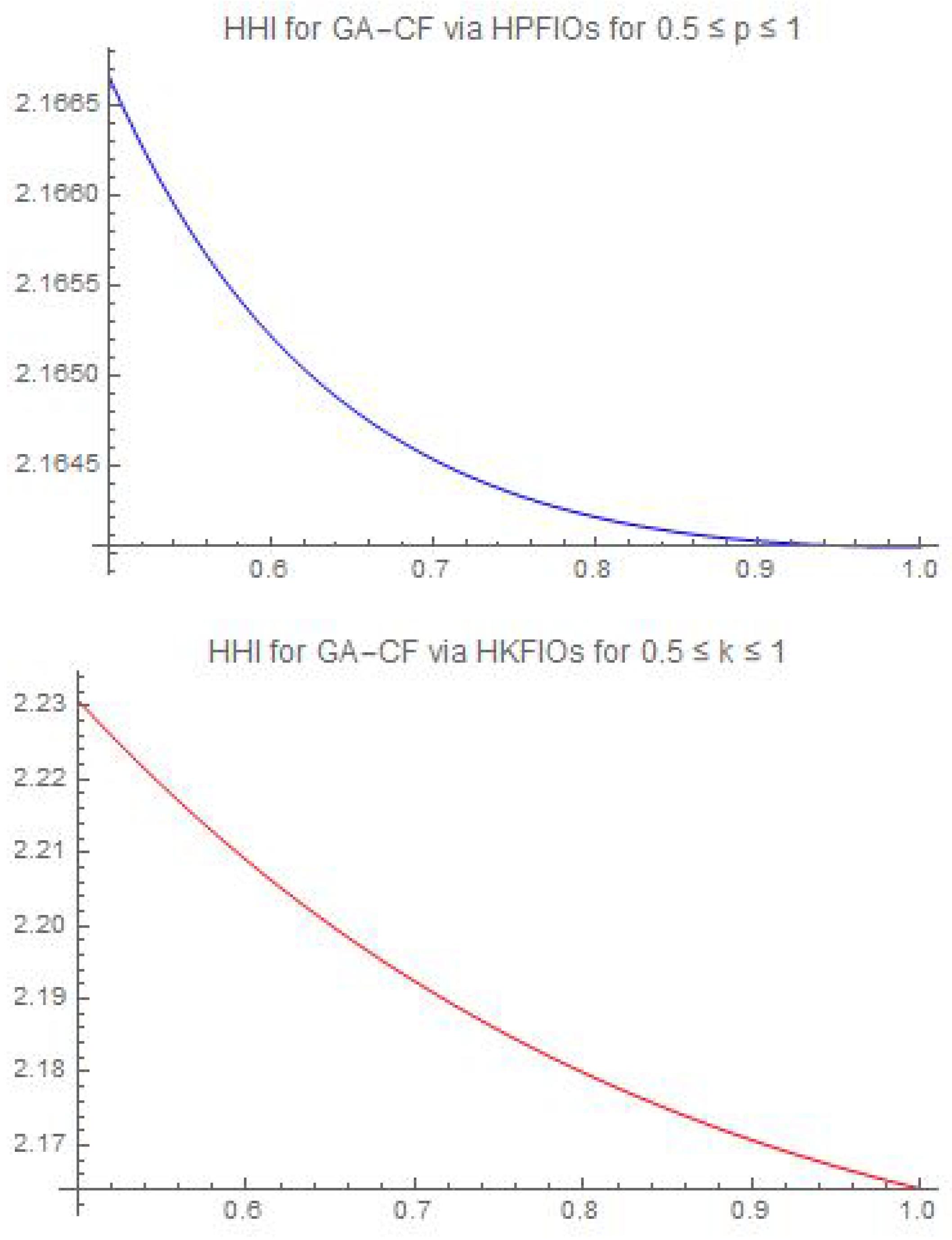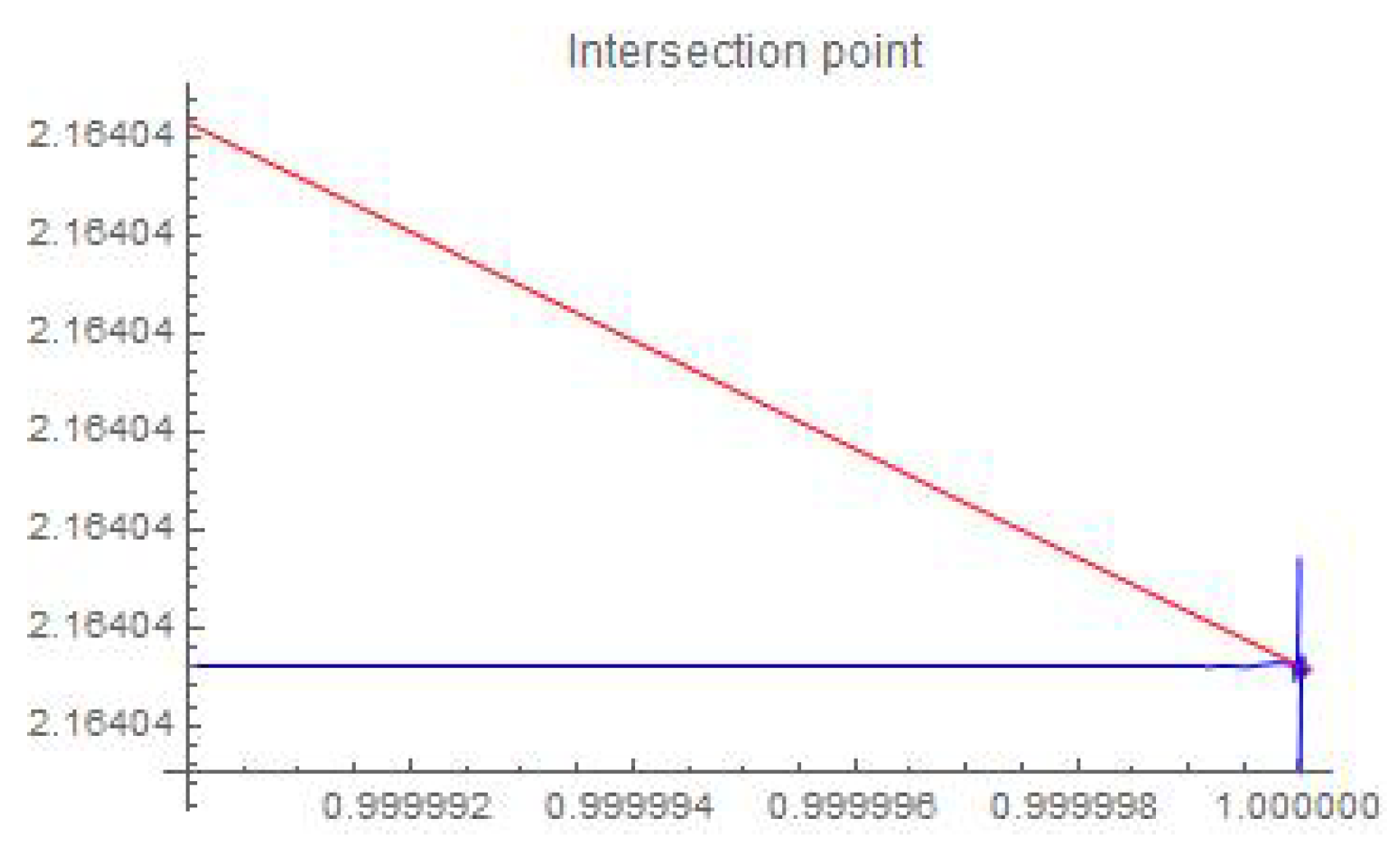New Inequalities for GA–h Convex Functions via Generalized Fractional Integral Operators with Applications to Entropy and Mean Inequalities
Abstract
1. Introduction
2. Basic Notions and Known Results
- •
- GA-s-CF if
- •
- GA-Q-CF if ,
- •
- GA-P-CF if
3. Results
- If we take in Corollary 1, we re-capture Corollary of [7].
- If we take in Corollary 2, we obtain Corollary 12 from [6].
- If we take in Corollary 3, then we reproduce Theorem from [37].
- Similarly to the case when in Remark 2, we obtain corresponding results for HFIO from [6].
- On the other hand, the consequence of Corollary 5 for yields the special case for HFIOs from [6].
4. Hermite–Hadamard-Mercer Inequalities for GA-h-CFs via Hadamard k-Fractional Integrals
- For the special case when in Theorem 6 (and Theorem 7), we obtain Theorem 13 (and Theorem 14) in [6].
- If we replace in Corollary 9, we reproduce Corollary of [7].
- If we take in Corollary 10, we obtain Corollary 12 from [6].
- If we take in Corollary 11, then we reproduce Theorem from [37].
- Similarly to the case when in Remark 4, we obtain corresponding results for HFIO from [6].
- On the other hand, the consequence of Corollary 13 for yields the special case for HFIOs from [6].
5. Comparison Between the Generalizations of Hermite–Hadamard–Mercer-Type Inequalities via GA-CFs via HPFIOs and HKFIOs
6. Applications
- (i)
- If , then
- (ii)
- (i)
- The inequalities (18) give the improved inequality for the arithmetic–geometric mean inequality. Letting above, we also obtain the known relation among the arithmetic mean, the geometric mean, and the logarithmic mean:where the arithmetic mean , the geometric mean and the logarithmic mean with , since we have . Thus, the inequalities (18) give the new interpolation relation between the arithmetic mean and the geometric mean.
- (ii)
- We easily find thatIt is known thatwhere is called the harmonic mean and . Then, in Theorem 9 showsAlthough the second inequality is trivial, the first inequality is not trivial.
- (i)
- If , then
- (ii)
7. Conclusions
Author Contributions
Funding
Institutional Review Board Statement
Informed Consent Statement
Data Availability Statement
Acknowledgments
Conflicts of Interest
References
- Kai, D. The analysis of fractional differential equations: An application-oriented exposition using differential operators of Caputo type. In Lecture Notes in Mathematics; Springer: Berlin/Heidelberg, Germany, 2004. [Google Scholar]
- Alshammari, S.; Alshammari, M.; Alabedalhadi, M.; Al-Sawalha, M.M.; Al-Smadi, M. Numerical investigation of a fractional model of a tumor-immune surveillance via Caputo operator. Alex. Eng. J. 2024, 86, 525–536. [Google Scholar] [CrossRef]
- Ferrari, A.L.; Gomes, M.C.S.; Aranha, A.C.R.; Paschoal, S.M.; de Souza, M.G.; de Matos, J.L.M.; Defendi, R.O. Mathematical modeling by fractional calculus applied to separation processes. Sep. Purif. Technol. 2024, 337, 126310. [Google Scholar] [CrossRef]
- Set, E.; Kashuri, A.; Mumcu, I. Chebyshev type inequalities by using generalized proportional Hadamard fractional integrals via Polya–Szegö inequality with applications. Chaos Solitons Fractals 2021, 146, 110860. [Google Scholar] [CrossRef]
- Kilbas, A.A.; Srivastava, H.M.; Trujillo, J.J. Theory and Applications of Fractional Differential Equations; Elsevier: Amsterdam, The Netherlands, 2006; Volume 204. [Google Scholar]
- Fahad, A.; Ayesha; Wang, Y.; Butt, S.I. Jensen–Mercer and Hermite–Hadamard–Mercer Type Inequalities for GA-h-Convex Functions and Its Subclasses with Applications. Mathematics 2023, 11, 278. [Google Scholar] [CrossRef]
- Iscan, I. Jensen—Mercer inequality for GA-convex functions and some related inequalities. J. Inequalities Appl. 2020, 212, 212. [Google Scholar] [CrossRef]
- Rahman, G.; Abdeljawad, T.; Jarad, F.; Khan, A.; Nisar, K.S. Certain inequalities via generalized proportional Hadamard fractional integral operators. Adv. Differ. Equ. 2019, 2019, 454. [Google Scholar] [CrossRef]
- Gambo, Y.Y.; Jarad, F.; Baleanu, D.; Abdeljawad, T. On Caputo modification of the Hadamard fractional derivatives. Adv. Differ. Equ. 2014, 2014, 10. [Google Scholar] [CrossRef]
- Iqbal, S.; Mubeen, S.; Tomar, M. On Hadamard k-fractional integrals. J. Fract. Calc. Appl. 2018, 9, 255–267. [Google Scholar]
- Tarasov, V.E. Entropy interpretation of Hadamard type fractional operators: Fractional cumulative entropy. Entropy 2022, 24, 1852. [Google Scholar] [CrossRef]
- Todinov, M. Reverse Engineering of Algebraic Inequalities for System Reliability Predictions and Enhancing Processes in Engineering. IEEE Trans. Reliab. 2023, 73, 902–911. [Google Scholar] [CrossRef]
- Huang, J.; Luo, D. Relatively exact controllability for higher-order fractional stochastic delay differential equations. Inf. Sci. 2023, 648, 119631. [Google Scholar] [CrossRef]
- Aydin, F. Boundary-aware local Density-based outlier detection. Inf. Sci. 2023, 647, 119520. [Google Scholar] [CrossRef]
- Akhtar, N.; Awan, M.U.; Javed, M.Z.; Rassias, M.T.; Mihai, M.V.; Noor, M.A.; Noor, K.I. Ostrowski type inequalities involving harmonically convex functions and applications. Symmetry 2021, 13, 201. [Google Scholar] [CrossRef]
- Khan, Z.A.; Afzal, W.; Nazeer, W.; Asamoah, J.K.K. Some New Variants of Hermite–Hadamard and Fejér-Type Inequalities for Godunova–Levin Preinvex Class of Interval-Valued Functions. J. Math. 2024, 2024, 8814585. [Google Scholar] [CrossRef]
- Mohammed, P.O.; Abdeljawad, T.; Alqudah, M.A.; Jarad, F. New discrete inequalities of Hermite–Hadamard type for convex functions. Adv. Differ. Equ. 2021, 2021, 122. [Google Scholar] [CrossRef]
- Srivastava, H.M.; Sahoo, S.K.; Mohammed, P.O.; Baleanu, D.; Kodamasingh, B. Hermite–Hadamard type inequalities for interval-valued preinvex functions via fractional integral operators. Int. J. Comput. Intell. Syst. 2022, 15, 8. [Google Scholar] [CrossRef]
- Huy, D.Q.; Van, D.T.T. Some inequalities for convex functions and applications to operator inequalities. Asian-Eur. J. Math. 2023, 16, 2350216. [Google Scholar] [CrossRef]
- Yang, W. Certain new weighted Young and Polya Szego-type inequalities for unified fractional inegral operators via an extended generalized Mittag-Leffler function with applications. Fractals 2022, 30, 2250106. [Google Scholar] [CrossRef]
- Beckenbach, E.F. Convex functions. Bull. Am. Math. Soc. 1948, 54, 439–460. [Google Scholar] [CrossRef]
- Noor, M.A.; Noor, K.I.; Rassias, M.T. Characterizations of higher order strongly generalized convex functions. Nonlinear Anal. Differ. Equ. Appl. 2021, 341–364. [Google Scholar]
- Luo, C.; Wang, H.; Du, T. Fejér—Hermite—Hadamard type inequalities involving generalized h-convexity on fractal sets and their applications. Chaos Solitons Fractals 2020, 131, 109547. [Google Scholar] [CrossRef]
- Mihai, M.V.; Noor, M.A.; Noor, K.I.; Awan, M.U. Some integral inequalities for harmonic h-convex functions involving hypergeometric functions. Appl. Math. Comput. 2015, 252, 257–262. [Google Scholar] [CrossRef]
- Niculescu, C.P. Convexity according to the geometric mean. Math. Inequal. Appl. 2000, 3, 155–167. [Google Scholar] [CrossRef]
- Latif, M.A.; Dragomir, S.S.; Momoniat, E. Some Fejér type integral inequalities for geometrically-arithmetically-convex functions with applications. Filomat 2018, 32, 2193–2206. [Google Scholar] [CrossRef]
- Noor, M.A.; Noor, K.I.; Awan, M.U. Some inequalities for geometricallyarithmetically h-convex functions. Creat. Math. Inform 2014, 23, 91–98. [Google Scholar] [CrossRef]
- Fahad, A.; Wang, Y.; Ali, Z.; Hussain, R.; Furuichi, S. Exploring properties and inequalities for geometrically arithmetically-Cr-convex functions with Cr-order relative entropy. Inf. Sci. 2024, 662, 120219. [Google Scholar] [CrossRef]
- Fahad, A.; Ali, Z.; Furuichi, S.; Wang, Y. Novel fractional integral inequalities for GA-Cr-convex functions and connections with information systems. Alex. Eng. J. 2025, 113, 509–515. [Google Scholar] [CrossRef]
- Dragomir, S.S.; Pearce, C. Selected Topics on Hermite–Hadamard Inequalities and Applications. Science Direct Working Paper No S1574-0358(04)70845-X. Available online: https://ssrn.com/abstract=3158351 (accessed on 14 October 2024).
- Ozdemir, M.E.; Ragomir, S.S.; Yildiz, C. The Hadamard inequality for convex function via fractional integrals. Acta Math. Sci. 2013, 33, 1293–1299. [Google Scholar] [CrossRef]
- Sun, W.; Liu, Q. Hadamard type local fractional integral inequalities for generalized harmonically convex functions and applications. Math. Methods Appl. Sci. 2020, 43, 5776–5787. [Google Scholar] [CrossRef]
- Sun, W. Some new inequalities for generalized h-convex functions involving local fractional integral operators with Mittag-Leffler kernel. Math. Methods Appl. Sci. 2021, 44, 4985–4998. [Google Scholar] [CrossRef]
- Vivas, M.; Hernández, J.; Merentes, N. New Hermite–Hadamard and Jensen type inequalities for h-convex functions on fractal sets. Rev. Colomb. MatemáTicas 2016, 50, 145–164. [Google Scholar] [CrossRef]
- Chen, J.; Luo, C. Certain generalized Riemann–Liouville fractional integrals inequalities based on exponentially (h, m)-preinvexity. J. Math. Anal. Appl. 2024, 530, 127731. [Google Scholar] [CrossRef]
- Du, T.; Peng, Y. Hermite–Hadamard type inequalities for multiplicative Riemann–Liouville fractional integrals. J. Comput. Appl. Math. 2024, 440, 115582. [Google Scholar] [CrossRef]
- Iscan, I. New general integral inequalities for quasi-geometrically convex functions via fractional integrals. J. Inequal. Appl. 2013, 491. [Google Scholar] [CrossRef]
- Kunt, M.; Iscan, I. Fractional Hermite–Hadamard–Fejér type inequalities for GA-convex functions. Turk. J. Inequal. 2018, 2, 1–20. [Google Scholar]
- Pachpatte, B.G. Integral and Finite Difference Inequalities and Applications; Elsevier: Amsterdam, The Netherlands, 2006. [Google Scholar]
- Varosanec, S. On h-convexity. J. Math. Anal. Appl. 2007, 326, 303–311. [Google Scholar] [CrossRef]
- Fujii, J.I. Relative operator entropy in noncommutative information theory. Math. Jpn. 1990, 35, 387–396. [Google Scholar]
- Yanagi, K.; Kuriyama, K.; Furuichi, S. Generalized Shannon inequalities based on Tsallis relative operator entropy. Linear Algebra Its Appl. 2005, 394, 109–118. [Google Scholar] [CrossRef]
- Furuichi, S. Advances in Mathematical Inequalities; Walter de Gruyter GmbH Co KG: Berlin, Germany, 2020. [Google Scholar]
- A Scientific and Technical Computing System Developed by Wolfram Research. Available online: https://www.wolfram.com/mathematica (accessed on 14 October 2024).



Disclaimer/Publisher’s Note: The statements, opinions and data contained in all publications are solely those of the individual author(s) and contributor(s) and not of MDPI and/or the editor(s). MDPI and/or the editor(s) disclaim responsibility for any injury to people or property resulting from any ideas, methods, instructions or products referred to in the content. |
© 2024 by the authors. Licensee MDPI, Basel, Switzerland. This article is an open access article distributed under the terms and conditions of the Creative Commons Attribution (CC BY) license (https://creativecommons.org/licenses/by/4.0/).
Share and Cite
Fahad, A.; Ali, Z.; Furuichi, S.; Butt, S.I.; Ayesha; Wang, Y. New Inequalities for GA–h Convex Functions via Generalized Fractional Integral Operators with Applications to Entropy and Mean Inequalities. Fractal Fract. 2024, 8, 728. https://doi.org/10.3390/fractalfract8120728
Fahad A, Ali Z, Furuichi S, Butt SI, Ayesha, Wang Y. New Inequalities for GA–h Convex Functions via Generalized Fractional Integral Operators with Applications to Entropy and Mean Inequalities. Fractal and Fractional. 2024; 8(12):728. https://doi.org/10.3390/fractalfract8120728
Chicago/Turabian StyleFahad, Asfand, Zammad Ali, Shigeru Furuichi, Saad Ihsan Butt, Ayesha, and Yuanheng Wang. 2024. "New Inequalities for GA–h Convex Functions via Generalized Fractional Integral Operators with Applications to Entropy and Mean Inequalities" Fractal and Fractional 8, no. 12: 728. https://doi.org/10.3390/fractalfract8120728
APA StyleFahad, A., Ali, Z., Furuichi, S., Butt, S. I., Ayesha, & Wang, Y. (2024). New Inequalities for GA–h Convex Functions via Generalized Fractional Integral Operators with Applications to Entropy and Mean Inequalities. Fractal and Fractional, 8(12), 728. https://doi.org/10.3390/fractalfract8120728






